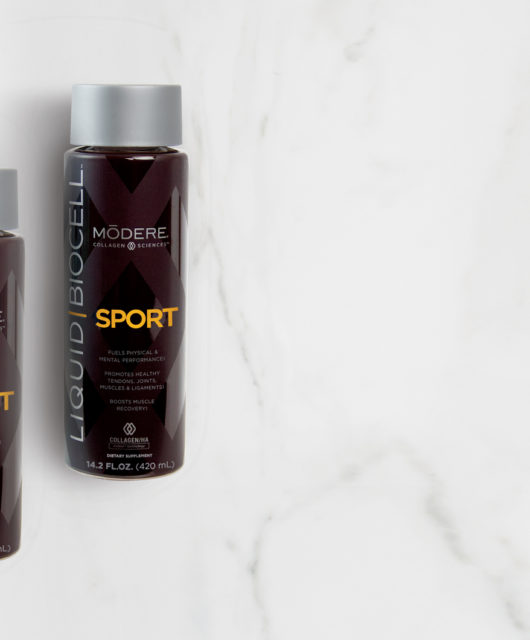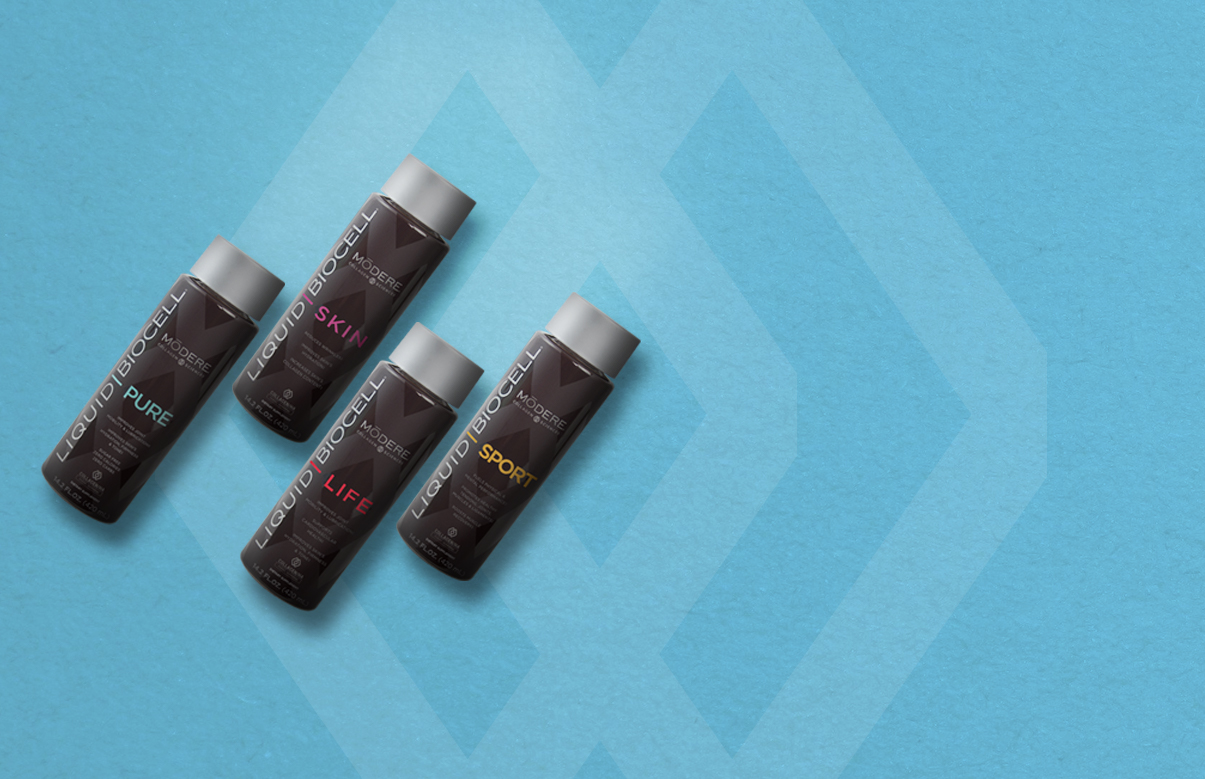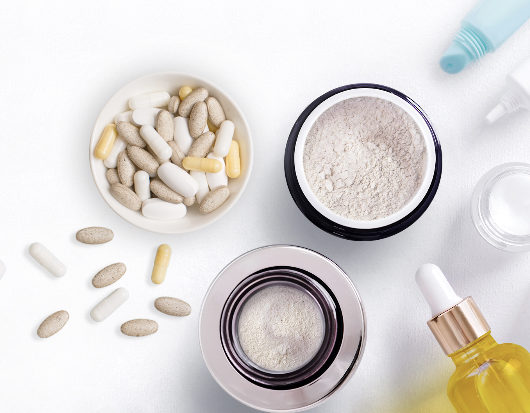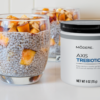Cellulite and dimpled skin are common concerns for women, especially in the summer when temps call for clothes that show off a bit more of your body. But for all the products out there that claim to combat “cottage cheese thighs,” “batwings,” or a “turkey neck,” is there anything that effectively helps skin look firm, toned and smooth?
Understanding the underlying causes of dimpled skin, including collagen loss, can help in finding effective solutions. Let’s dive into the science of cellulite.
The Science of Cellulite
Cellulite is a complex condition influenced by various factors including:
- Structural changes in the skin
- Fat distribution
- Hormones
- Blood circulation
- Genetics
- Collagen loss
And multiple factors may be in play at the same time, which is why the appearance of cellulite can be so hard to minimize.
Cellulite Cause #1: Structural Changes In Skin
Underneath the skin, there’s a layer of connective tissue called the septae that separates your fat cells into compartments. Factors like aging, weight gain or hormonal changes can affect this connective tissue and its ability to help keep skin looking firm, resulting in a dimpled or lumpy appearance on the surface of the skin. This is known as cellulite.[1]
While aging and some hormonal changes are unavoidable, it is possible to support your skin’s connective tissue to increase firmness and elasticity from the inside out. And if you’re pursuing healthy changes in body composition, like losing weight, it’s important to pair diet and exercise with a plan to support skin’s elasticity as part of your weight management program. Keep reading to find out how.
Cellulite Cause #2: Fat Distribution
The distribution of fat cells and their size play a role in the development of cellulite. In women, fat cell compartments are arranged vertically. In men, they’re arranged in a crisscross pattern. The crisscross structure is better at promoting a smooth and firm appearance, whereas a vertical structure allows fat cells to be more visible from the surface of the skin.
What’s more, women have more layers of subcutaneous fat than men. Women have 3 layers of fat in their thigh/hip area, abdomen and upper arm area — men only have 1 layer of fat throughout their entire body.[2],[3]
Cellulite Cause #3: Hormonal Factors
Hormonal changes, such as those occurring during puberty, pregnancy or menopause, can influence the development of cellulite. Estrogen, insulin, thyroid hormones and noradrenaline are all thought to play a role in the formation of cellulite by affecting blood flow, fat distribution, and collagen production.[4]
More specifically, estrogen plays an important role in fat cell size. Estrogen encourages fat cell growth whereas testosterone is linked to a reduction in fat cells (another reason why cellulite affects women more than men).
And if it seems like you’re noticing more cellulite or saggy skin in your menopausal years, you’re not going crazy. Declining estrogen levels are linked to decreased collagen production, so your skin may start to look less firm. Plus, menopause shifts where your body stores fat, so you may see cellulite popping up in places you hadn’t noticed it before.
Cellulite Cause #4: Blood Circulation
Poor blood circulation can contribute to the accumulation of lymphatic fluid and toxins in your fat cells, making them swell and become more visible beneath the skin’s surface. Factors like sedentary lifestyle, smoking, dehydration and tight clothing can impair circulation and worsen the appearance of cellulite.[5]
Cellulite Cause #5: Genetic Predisposition
Genetics play a significant role in determining whether you are prone to cellulite. Certain genetic factors can influence skin thickness, elasticity and the structure of your septae, making some individuals more susceptible to cellulite than others (thanks, mom).1
Cellulite Cause #6: Collagen Loss
Collagen is a key structural protein in the skin that provides support and elasticity. Beginning in your 20s, the production of collagen decreases, leading to a loss of skin firmness and tone. Weakened collagen fibers affect the structure of fat-storing septae in subcutaneous layers of skin, which contributes to the appearance of cellulite.[6]
A Closer Look at Cellulite & Collagen
Collagen is essential for maintaining skin strength and elasticity. When collagen levels decline, the skin becomes thinner and loses its ability to bounce back, resulting in a saggy, crepey or wrinkled appearance. Additionally, weakened collagen fibers can allow fat cells to push through the connective tissue beneath the skin, creating the characteristic dimpled appearance of cellulite.
Because collagen is so important to the structure of your connective tissue, slowing collagen loss is essential to reducing the appearance of cellulite, saggy skin and wrinkles.
Tips for Reducing Collagen Loss
- Eat a Healthy Diet: A balanced diet rich in fruits, vegetables, lean proteins and whole grains provides essential nutrients for collagen production and overall skin health. In particular, foods rich in vitamin C, zinc, copper and amino acids have been shown to support healthy collagen levels.
- Stay Hydrated: Drinking an adequate amount of water is crucial for maintaining skin hydration and elasticity. Aim for 120 fluid ounces of water per day for men, and 90 ounces for women, to keep your skin looking plump and firm.
- Exercise: Engaging in regular physical activity not only helps burn excess fat but also improves circulation essential to collagen production. Incorporate a combination of cardiovascular exercise, strength training and flexibility exercises into your routine for optimal results.
- Maintain a Healthy Weight: Excess body fat can exacerbate the appearance of cellulite. By maintaining a healthy weight through a balanced diet and regular exercise, you can minimize the accumulation of fat cells beneath the skin.
- Try Collagen Supplements: There are a lot of collagen supplements on the market. But some yield significantly more dramatic results than others. Why? It has to do with the type of collagen used and how it’s manufactured. However, with the right formulas, you can not only increase skin’s elasticity, but you may also be able to help reduce the enzyme that contributes to skin aging. (More on that in the next section!)
The Power of Collagen/HA Matrix® Technology
Unlike other collagen supplements and topical collagen skincare products, Modere collagen products feature a single-source matrix of collagen, hyaluronic acid and chondroitin sulfate that mirrors human articular cartilage composition. In other words, it’s an ideal collagen ingredient because your body recognizes it. And because it’s not just collagen (it naturally includes HA and chondroitin sulfate essential to connective tissue health), it provides more comprehensive support than collagen alone.
What’s more, our collagen products undergo a patented Bio-Optimized™ manufacturing process that results in collagen micromolecules of the ideal molecular weight for your body to use. Whether you’re supplementing with award-winning Liquid BioCell® nutraceutical or weight management-supplement Trim, or incorporating topical BioCell Collagen® CG into your skincare routine, you’ll experience noticeable benefits.
In fact, Collagen/HA Matrix Technology is backed by multiple scientific studies:
- Increases skin’s HA levels by 6000% in 28 days, reducing wrinkles from the inside out*
- May reduce hyaluronidase, an enzyme that contributes to skin aging and the breakdown of collagen over time*
- May directly activate cells in the body to produce new collagen*
A Collagen Routine to Reduce the Appearance of Cellulite
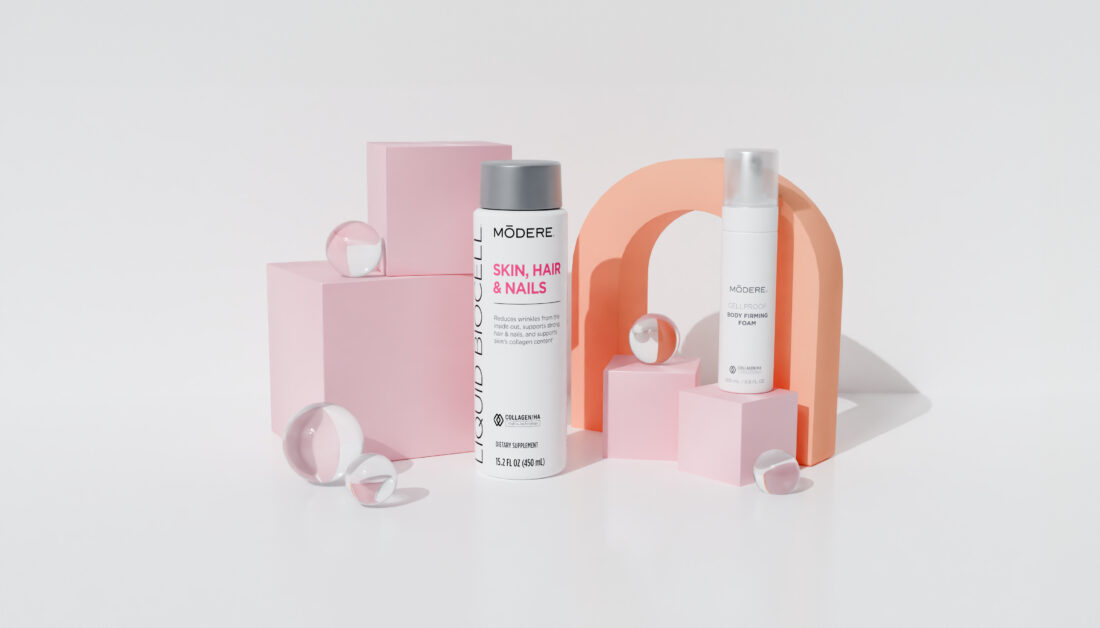
Want an inside-out approach to target the look of cellulite and sagging skin? We’ve got you covered with just 2 products daily, backed by Collagen/HA Matrix® Technology.
Step 1: Take 1 Tablespoon of Liquid BioCell® Skin, Hair & Nails (AM + PM).
Step 2: Apply 2-5 pumps of Modere CellProof Body Firming Foam to target areas.
Why Liquid BioCell® Skin, Hair & Nails?
This Liquid BioCell formula is formulated with biotin, essential to skin health, and 18 phytonutrient-rich superfoods. It delivers all the studied benefits of Collagen/HA Matrix® Technology, including the ability to:
- Reduce wrinkles from the inside out*
- Support skin’s collagen content*
- Help reduce dryness*
- Support skin’s microcirculation, hydration, skin tone and firmness*
- Potentially reduce hyaluronidase, the enzyme that can contribute to skin aging*
- Support joint mobility and lubrication*
- Support joint health and comfort*
- Help improve muscle tone*
Why Modere CellProof Body Firming Foam?
This lightweight foam features a hydro-firming formula with Macaline® Maca and Pro-Sveltyl OP®, plus Collagen/HA Matrix® Technology in BioCell Collagen® CG. It can be applied anywhere you notice cellulite, crepey skin or sagging skin. We love using it on the neck, upper arms, abdomen thighs, hips and derriere to:
- Smooth the appearance of cellulite and dimpled skin
- Restore a firmer, toned appearance to targeted areas
- Reduce the appearance of skin imperfections
- Improve skin elasticity and resiliency
- Soothe skin
- Moisturize, soften and nourish skin
Pro tip: If you’re trying to lose inches as part of a diet & exercise program,you can swap 1 Tablespoon of Liquid BioCell® daily for 1 Tablespoon of Trim. This unique weight management formula delivers scientifically studied CLA that may inhibit cellular fat storage, reduce fat cell size and reduce fat cell formation, and combines it with Collagen/HA Matrix® Technology to support connective tissue health.*
Our goal is to help you love your body and design a life where you feel confident! Having cellulite is perfectly natural, especially for women, no matter your shape or size. While factors like genetics and hormones play a role in the appearance of cellulite, lifestyle habits and collagen loss also contribute significantly. By adopting a healthy lifestyle and incorporating a collagen-based skincare and supplement routine, you can effectively reduce the appearance of crepey skin and cellulite and improve skin’s overall tone and texture, so you can look as vibrant as you feel.
| *This statement has not been evaluated by the Food and Drug Administration. These products are not intended to diagnose, treat, cure or prevent any disease. |
[1] Cellulite – Symptoms and causes – Mayo Clinic. (2023, November 21). Mayo Clinic. https://www.mayoclinic.org/diseases-conditions/cellulite/symptoms-causes/syc-20354945
[2] Harmon, K. (2009, May 4). Is cellulite forever? Scientific American. https://www.scientificamerican.com/article/is-cellulite-forever/
[3] Avram, M. M. (2004). Cellulite: A Review of Its Physiology and Treatment. Journal of Cosmetic and Laser Therapy, 6(4), 181–185.
[4] https://www.ncbi.nlm.nih.gov/pmc/articles/PMC4520379/
[5] https://www.ncbi.nlm.nih.gov/pmc/articles/PMC6232550/
[6] Varani, J. et al. (2006). Decreased Collagen Production in Chronologically Aged Skin: Roles of Age-dependent Alteration in Fibroblast Function and Defective Mechanical Stimulation. The American Journal of Pathology, 168(6), 1861–1868.

